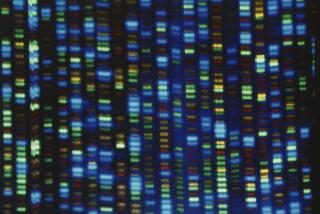$3-Billion Effort to Map Every Human Gene Sought
- Share via
WASHINGTON — A panel of the National Academy of Sciences on Thursday urged the federal government to launch history’s most ambitious biological research project, a $3-billion effort over the next 15 years to map the location of every gene on the chromosomes in living cells that carry the human genetic blueprint.
Reflecting what appears to be a consensus in the scientific community, the panel’s report said such a detailed map of the human genetic material would have a profound effect over decades on the understanding of disease and a vast array of normal biological processes.
This project would in turn, the panel said, pave the way for the ultimate understanding of human genetics: deciphering the precise, coded sequences of the four organic molecules known as nucleotides that make up each of the 100,000 genes in the human biological blueprint.
“Such a special effort in the next two decades will greatly enhance progress in human biology and medicine,” the 15-member panel said.
The entire human genetic code consists of an estimated 3 billion nucleotides, arranged in sequence along the spiral strands of DNA molecules that make up the genetic material of living organisms. A printed version of the human genetic code, written in sequences of the four letters used to designate the four types of nucleotide in DNA--A, G, C and T for adenine, guanine, cytosine and thymine--would fill a million pages of textbook size.
The panel’s report said that “unprecedented advances” in the last decade in molecular biology, genetics and related fields “define this as a unique and opportune moment in our history.”
“For the first time we can envision obtaining easy access to the complete sequence of the 3 billion nucleotides in human DNA and deciphering much of the information contained therein.”
At the same time, the researchers acknowledged that a complete deciphering of the human genetic code would raise “challenging issues regarding rational, wise and ethical uses of science and technology.”
In assessing the potential benefits, the scientists noted that mankind is now known to be afflicted by 3,000 different inherited disorders, which stem from genetic defects. Thus far, researchers have identified the responsible gene in only a small number of these disorders--such as sickle-cell anemia and hemophilia.
Genetic Role in Cancer
Recent research, they noted, has pointed to an important genetic role in cancer, high blood pressure, diabetes, schizophrenia and neurological disorders such as Alzheimer’s disease, among other afflictions.
“Once you know where a defective gene is on the map, you can design a diagnostic test” that predicts susceptibility to a disease, Dr. Victor McKusick, a pioneer in the study of the genetic origins of disease at Johns Hopkins University, explained during the academy seminar Thursday.
“Knowing where the gene itself is, you can walk into it and see what is wrong with the piece of DNA that is causing the disease,” McKusick said. Understanding how a gene causes a disease then opens the way to designing a treatment to interrupt the process.
The proposal, which has been gathering momentum in the research community for the last two years, places biology in competition with high-energy physics. Aided by state governments eager to win a major public works project, physicists won the Reagan Administration’s endorsement last year of the largest scientific instrument ever planned, a 53-mile-around atom smasher called the superconducting super collider that would cost $4.4 billion if Congress consents to pay for it.
A Foot in the Door
The timing of the biologists’ bid for a multibillion-dollar enterprise, a week before President Reagan is to propose his last budget, suggests that some may hope to gain a similar endorsement and a foot in the door before the change of administrations.
The government’s National Institutes of Health and the Department of Energy are spending about $30 million this year on the initial stages of a human gene-mapping project, but the academy panel urged that this be raised over the next several years to an annual budget of $200 million. It recommended that the 15-year project be coordinated by a single federal agency such as the NIH, DOE or the National Science Foundation.
Arguing for the project, the scientists said $200 million would add only 3% to current federal funding for biological research. They emphasized that the money should not be taken from existing projects. They also urged that it be divided among a number of competing laboratories rather than being concentrated on a single factorylike center in order to promote rapid development of improved technology needed to carry out gene mapping and sequencing.
Other Nations Interested
Although it acknowledged that other countries have an active interest in gene-mapping techniques--notably Japan, France, West Germany and Great Britain--the panel stopped short of suggesting an international project that would divide the costs and the laborious research work.
However, Bruce M. Alberts, a professor of biochemistry at UC San Francisco who headed the study panel, said a major U.S. effort would quickly attract international support and cooperation.
Asked how the Administration or Congress should go about deciding which deserves priority--a multibillion-dollar atom smasher meant to preserve American leadership in high-energy physics, or an almost equally expensive gene-mapping project--Alberts shrugged and smiled.
“That’s for someone else to adjudicate, not biologists,” he said. But the panel members maintained that the gene-mapping project is likely to have a more immediate payoff.
“This is not like sending a rocket to Mars,” Alberts observed. “Even in five to 10 years this project should pay off . . . in alleviating human suffering.”






